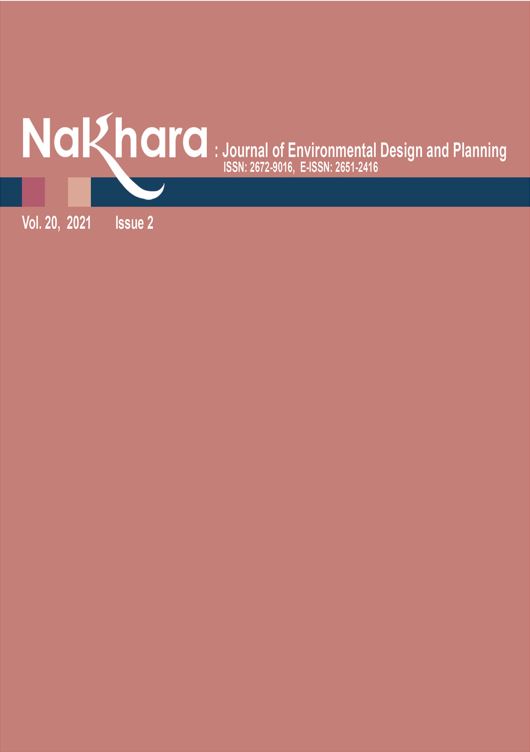Postmodern Architecture in Thailand 1982–1997: Key Concepts and Case Studies
Main Article Content
Abstract
Since the 1960s, Postmodern architecture has been popular in Western societies. It emerged as a response to the Modernism style by rejecting the abstract elements of architecture and included a return to the communication of architectural meaning for the public. This approach led to the representation of architectural elements from the past and re-considered how culture was reflected in design. Postmodern architecture became popular in Thailand during the 1980s, resulting in the creation of numerous Postmodern buildings in all regions of the country. The objective of this article is to characterize Postmodern architecture in Thailand from 1982 to 1997 (2525–2540 B.E.) and demonstrate the value and importance of such architecture, which is deserving of preservation. The research process included a study of Postmodernism in Western societies; an examination of Postmodern architecture in Thailand through various documents; surveys of six case studies and analyzes of their key concepts and significant architectural characteristics. Based on seminal research led by Vimolsiddhi Horayangkura, Postmodern architecture in Thailand consists of four sub-styles: Historicism, Contextualism, Pluralism, and Behavioralism. These four sub-styles are used as a framework of analysis to re-evaluate both the classification and projects. The adoption of Historicism in the early stage of Postmodernism in Thailand was consistent with the economic prosperity of the middle class, which created a specific meaning for Thai society. The popularity of Postmodern style, particularly Historicism, declined and paralleled with the economic crisis in 1997. The architecture field thus began to focus more on promoting Thai identity or Thai-ness, with which the other three sub-styles were integrated and continued. After reviewing the six building case studies, it was concluded that Postmodern architecture in Thailand has some outstanding key concepts, including Historic Preservation, Historical Allusion, Contextual Linkage, Placemaking, Double-Coding Composition, Eclectic Composition, Specific Signification, and Lifestyle Pattern as Organization. These key concepts reveal interrelation among the four sub-styles and prove that each architectural project cannot be labelled with one sub-style. They also demonstrate the adaptation to the context and way of life of the pluralistic Thai society.
Article Details

This work is licensed under a Creative Commons Attribution-NonCommercial-NoDerivatives 4.0 International License.
References
Arun Chaiseri Consulting Engineers. (2012). Amarin Plaza, Bangkok. www.arunchaiseri.co.th/consultant/sd/past-experiences.php?page=7
Baker, C., & Phongpaichit, P. (2005). A history of Thailand. Cambridge University Press.
Coconuts Bangkok. (2016, January 14). Scary skyscraper: Bangkok’s ‘haunted’ Ghost Tower. https://coconuts.co./bangkok/features/scary-skyscraper-bangkoks-haunted-ghost-tower/
Horayangkura, V., Intarawijit, K., Chantavilasvong, S., & Inpuntung, V. (1993). Development of concepts and designs of architecture: Past, present and future. The Association of Siamese Architects under the Royal Patronage.
Jacobs, J. (1961). The death and life of great American cities. Random House.
Jameson, F. (1991). Postmodernism, or the cultural logic of late capitalism. Verso.
Jencks, C. (1984). The language of postmodern architecture (4th ed.). Rizzoli International Publications.
Jencks, C. (2011). The story of post-modernism: Five decades of the ironic, iconic and critical in architecture. John Wiley & Sons.
Jumsai, S. (1991). Bangkok: Robot bank and the Queen Sirikit National Convention Center. Architecture and Development in Southeast Asia.
Klampaiboon, S. (2011). Democracy is “ours." Siam Publishing.
Krier, L. (1978). Rational architecture. AAM Editions.
Mallgrave, H. F., & Goodman, D. (2011). An introduction to architectural theory 1968 to the present. Wiley-Blackwell.
Portoghesi, P. (1983). Postmodern, the architecture of the postmodern society. Rizzoli International Publications.
Rossi, A. (1966). L'architettura della città [The Architecture of the City]. Issue 8 of Biblioteca di architettura e di urbanistica. Marsilio.
Rossi, A. (1984). The architecture of the city. The MIT Press.
Rowe, C., & Koetter, F. (1978). Collage city. The MIT Press.
The Association of Siamese Architects under the Royal Patronage. (1987a). Merchant house in countryside. ASA Journal of Architecture April 1987, 12(5), 42–47
The Association of Siamese Architects under the Royal Patronage. (1987b). Plan house. ASA Journal of Architecture April 1987, 12(5), 34–39.
The Association of Siamese Architects under the Royal Patronage. (1997). Library and multi-purpose building 2, Thammasat university Tha Phrachan. ASA Journal of Architecture August 1997, 22(8), 74–86.
The Association of Siamese Architects under the Royal Patronage. (2016a). Dome Building Thammasat University. https://asaconservationaward.com/index.php/2016-06-13-15-21-44/building-2548/63-dome-thammasat-university
The Association of Siamese Architects under the Royal Patronage. (2016b). Hotel Sofitel Central Hua Hin. https://asaconservationaward.com/index.php/2016-06-13-15-23-31/commercial2537/338-hotel-sofitel-central-hua-hin
Tiptus, P. (1996). Siamese architects: Fundamentals, roles, works and concepts (1932–1994). Association of Siamese Architects under the Royal Patronage.
Torsuwan, R. (1989). Imaginations image and design concept. Rangsan Architecture.
Venturi, R. (1966). Complexity and contradiction in architecture. Museum of Modern Art.
Venturi, R. (1972). Learning from Las Vegas: The forgotten symbolism of architectural form. The MIT Press.
Wangrungarun, C. (Ed.) (1992). Ong-ard architects: Design Excellence 1. The Key Publisher.
Wangrungarun, C. (Ed.) (1996). Sumet Jumsai: Design Excellence 3. The Key Publisher.
Wasiksiri, D. (2016). New architecture after modernism. Common Books.
Woods, T. (1999). Beginning postmodernism. Manchester University Press.

